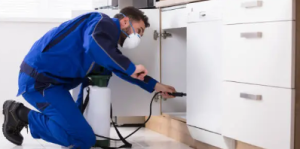One of the things of importance in strata and body corporate buildings is termite infestation management, which is important not just to the structural integrity but also to the financial health of the building. With significant costs attached to the damage these insects cause, there is a great need for measures of effective pest control. Knowing termite behaviour and providing practical prevention tips to the best professional treatments, this guide provides effective preventive measures that may help homeowners avoid termite problems, reduce remediation costs, and preserve value and safety.
Understanding Termite Infestation in Strata Properties
Termite infestation in strata properties is best understood as a proactive process since strata properties involve shared living spaces and common areas. Termites are not visible, yet they create a huge impact on the structural integrity of the building. They feed on cellulose, which is present in large amounts in building lumber, and damage these buildings with costly repairs, reducing their value over time.
Effective management begins with an awareness of the signs that could indicate termite activity: hollow-sounding timber, mud tubes on exterior walls, and discarded wings. This is why regular inspections are crucial to assist in the early detection of possible infestations. Due to the communal type of ownership of strata property, individual owners and body corporates bear different responsibilities regarding timely reporting and treatment of any termite problem, thus protecting the structural integrity of the building and the investment of the residents.
Cost-Effective Termite Treatment Options
The termite pest control services to protect strata properties from very costly damage must be addressed in its own right. Here are the treatments that provide long-term termite protection by enabling strata managers and property owners to maintain structural integrity without overinvesting in this area.
Baiting Systems
Baiting systems are an effective, very environmentally friendly method of termite control. The baiting systems involve the placing of bait stations around the property strategically, which attracts termites into a poison that acts very slowly, to be taken back into their colony. Eventually, this can wipe out whole termite populations. Baiting systems are cost-effective, particularly for huge strata properties, because they limit the requirement to use widespread chemical applications; instead, they offer ongoing protection.
Chemical Barriers
This is a treatment whereby a liquid termiticide is applied to the soil along the building perimeter to establish a barrier that the termites cannot penetrate. It prevents termites from entering the property and may remain functional for several years if properly maintained. Though the upfront cost may be a little higher, it provides very effective long-term protection against future infestation; thus, it ensures value for money for strata properties.
Direct Chemical Treatments
The direct application of chemical treatments to the site of infestation itself means that chemical treatments can be applied directly to the source of the termite problem. It is, therefore, of particular benefit in localised outbreaks within strata property because applications can be made in a very precise manner to minimise the amount of chemicals applied and, consequently, the cost. The real advantage of this method over broader treatments is that termite activity can be controlled by treating specific areas only, rather than the need to blanket treat entire buildings at great cost.
Physical Barriers
Physical barriers are a preventive system consisting of the installation of stainless steel mesh or crushed rocks at the base of the foundation or the perimeter of the building. Termites will, therefore, not get an access point leading to the structure, since it blocks them physically. The upfront installation cost may be expensive, but physical barriers can serve a very long-term purpose when maintenance is required. It is, therefore, a very good investment for strata properties.
Heat treatment
In heat treatment, a harmless eco-friendly process, the temperature of the termite-infested area is raised to lethal levels. This is a highly effective treatment and leaves no chemical residue within the structure, hence becoming an ideal choice for property managers concerned about ecology. It might be a little more costly than a few chemical treatments, but it works out cost-effectively because termites can be treated in one application without harmful side effects.
Cold Therapy
The cold treatment involves the freezing of termites using liquid nitrogen. This is a non-toxic application that is very effective against places that the other two methods may not reach. It’s an efficient way out, so it suits strata pest control, where maximum containment is necessary. While this may be a bit more expensive per application, it also works out to be cheaper in the long run by curbing greater structural damages.
Preventive Measures to Avoid Termite Problems
Termite outbreaks in strata properties can be prevented by taking proactive approaches to address potential vulnerabilities before actual problems arise. Regular maintenance is key in this respect, sealing entry points like cracks in the foundation, windows, and doors, as well as ensuring minimal wood-to-soil contact. Another very important aspect is moisture control. Termites love damp conditions; therefore, fix all leaks and ensure proper drainage around the property. Landscaping also plays a part; plants and mulch should be kept away from the building’s foundation to discourage termites from finding points of entry.
Educating residents about the early signs of termite activity and encouraging good housekeeping practices can further help in preventing infestations. The professionals should conduct regular inspections of individual units and common areas for early detection before any issues get out of hand.
Regular Inspection and Maintenance Schedules
A routine inspection and maintenance schedule is important in the early detection or prevention of termite infestations within strata properties. Indeed, professional inspections should be carried out at least once a year, while more frequent checks in high-risk areas like the basement, attic, and crawl spaces should be highly considered. The inspections will help in identifying signs of termite activities, such as mud tubes, damaged wood, or even discarded wings before they increase into serious issues.
Also, by following a regular plan of building maintenance such as repairing leaks, checking on ventilation, or simply keeping up the yard, termite infestation can be prevented. Routine maintenance also involves checking and renewing any existing termite barriers or baiting systems for continued effectiveness. Through the implementation of strict inspection and maintenance, strata managers can prevent costly termite damages, maintain property values, and provide a safe living environment for residents.
Conclusion
Effective termite management in strata and body corporate buildings avoids costly repairs to maintain property integrity. Taking preventive measures, going through regular inspections, and choosing cost-effective treatment options will ultimately enable property managers to protect their investments and provide a safe environment for the residents. A proactive approach, together with professional expertise, goes some way in reducing risks associated with termite infestation, saving time, money, and stress in the end. Long-term success is achieved in termite prevention and control by regular maintenance, education, and cooperation by the individual owner and the body corporate.
FAQS
How frequently should the strata properties be checked for termites?
Termite inspections of strata property should be made at least annually by a professional, though more frequent inspections are important in higher-risk areas. In most cases, regular inspections enable the early detection of signs of infestation so that treatment can be timely and prevent extensive and costly damage.
What is the evidence of an infestation of termites in strata buildings?
Common signs of termite infestation include hollow-sounding wood, mud tubes along the walls, discarded wings near windows or doors, and visible signs of wood structure damage. Regular inspections are important in ascertaining these signs, especially in common areas such as the basement and the attic.
Are chemical barriers effective for termite prevention?
Yes, chemical barriers are very effective in preventing termites from entering a property. It sets up a zone in the soil around the building that termites cannot cross. If applied correctly, these barriers have long-lasting effectiveness, thus being cost-effective for strata properties.
How do baiting systems work to control termites?
Baiting systems consist of placing baits around the property to attract termites. Termites tend to forage, take the baits, and kill the whole colony. These are very friendly treatment methods in the environment and are cost-effective for a big strata property.
What can be done to prevent termite infestation?
Preventive measures include sealing the cracks in the foundation, minimizing wood-soil contact, controlling moisture, and proper drainage. Regular maintenance and periodic inspections are also vital. Educating residents on termite signs and good housekeeping practices would further prevent the occurrence of an infestation.
Note: This is a collaborative post


No Comments